Effect of Er on Microstructure and Mechanical Properties of 5052 Aluminum Alloy with Big Width-To-Thickness Ratio
Abstract
:1. Introduction
2. Materials and Methods
3. Results and Discussion
3.1. Microstructure
3.2. Mechanical Properties
4. Conclusions
- (1)
- The microstructure of the as-cast 5052 aluminum alloy with a big width-to-thickness ratio was mainly composed of α-Al and Al3Fe. After adding Er, the second phase was slightly refined, and Al3Fe was transformed into Al6Fe and AlEr with/without a small amount of Fe or Si. The effect of Er on grain refinement was related to its content. When Er content was lower or higher than 0.4%, the grain would coarsen.
- (2)
- Homogenization had little effect on the grain size of the 5052 aluminum alloy with a big width-to-thickness ratio, but it could improve the uniformity of grain size distribution. Homogenization was conducive to refining the grain by controlling Er content and distribution in the Al matrix. AlFeSiEr with a refining effect might be a mixture of multiple phases blending with each other.
- (3)
- The ultimate tensile strength, yield strength and elongation of the as-cast 5052 aluminum alloy with a big width-to-thickness ratio were 197 MPa, 117 MPa and 22.5% respectively. The strength was the highest, when Er content was 0.4% and the elongation was the best at 0.1% Er content. Long time homogenization at high temperature would significantly reduce the strength of the 5052 aluminum alloy and 5052 aluminum alloys with low Er content, but help to improve the plasticity of those with high Er content.
- (4)
- The fracture morphology of cold-rolled 5052 aluminum alloys with a big width-to-thickness ratio was composed of a necking region, brittle fracture region and ductile fracture region. With the increase of Er content, the width and the average dimple size of DFR were gradually decreasing, while the width of BFR was slowly increasing, which was consistent with the change of elongation.
Author Contributions
Funding
Conflicts of Interest
References
- Zhang, X.M.; Deng, Y.L.; Zhang, Y. Development of high strength aluminum alloys and processing techniques for the materials. Acta Metall. Sin. 2015, 51, 257–271. [Google Scholar]
- Yang, H.; She, X.W.; Tang, B.B.; Li, C.M.; Jiang, X.Q. Study of the microstructure and ring element segregation zone of spray deposited SiCp/7055Al. Materials 2019, 12, 1299. [Google Scholar] [CrossRef] [PubMed] [Green Version]
- Yu, T.Y.; Hyer, H.; Sohn, Y.H.; Bai, Y.L.; Wu, D.Z. Structure-property relationship in high strength and lightweight AlSi10Mg microlattices fabricated by selective laser melting. Mater. Des. 2019, 182, 108062. [Google Scholar] [CrossRef]
- Shabestari, S.G. The effect of iron and manganese on the formation of intermetallic compounds in aluminum-silicon alloys. Mater. Sci. Eng. A 2004, 383, 289–298. [Google Scholar] [CrossRef]
- Suarez-Pena, B.; Asensio-Lozano, J. Influence of Sr modification and Ti grain refinement on the morphology of Fe-rich precipitates in eutectic Al-Si die cast alloys. Scr. Mater. 2006, 54, 1543–1548. [Google Scholar] [CrossRef]
- Liao, Y.G.; Han, X.Q.; Zeng, M.X.; Jin, M. Influence of Cu on microstructure and tensile properties of 7xxx series aluminum alloy. Mater. Des. 2015, 66, 581–586. [Google Scholar] [CrossRef]
- Zykova, A.; Martyushev, N.; Skeeba, V.; Zadkov, D.; Kuzkin, A. Influence of W addition on microstructure and mechanical properties of Al-12%Si alloys. Materials 2019, 12, 981. [Google Scholar] [CrossRef] [Green Version]
- Tzeng, Y.C.; Wu, C.T.; Bor, H.Y.; Horng, J.L.; Tsai, M.L.; Lee, S.L. Effects of scandium addition on iron-bearing phases properties of Al-7Si-0.6Mg alloys. Mater. Sci. Eng. A 2014, 593, 103–110. [Google Scholar] [CrossRef]
- Jiang, Y.; Liu, F. Effects of Sc or/and Ge addition on microstructure and mechanical properties of as-cast 6016 Al alloy. J. Alloy. Compd. 2019, 809, 151829. [Google Scholar] [CrossRef]
- Pandee, P.; Patakham, U.; Limmaneevichitr, C. Microstructural evolution and mechanical properties of Al-7Si-0.3Mg alloys with erbium additions. J. Alloy. Compd. 2017, 728, 844–853. [Google Scholar] [CrossRef]
- Guo, T.B.; Wang, B.; Zhang, Z.F.; Sun, Q.Z.; Jin, Y.H.; Ding, W.W. Effect of micro-scale Er on the microstructure and fluidity of ZL205A alloy. Materials 2019, 12, 1688. [Google Scholar] [CrossRef] [PubMed] [Green Version]
- Zhang, X.; Wang, Z.H.; Zhou, Z.H.; Xu, J.M. Effects of cerium and lanthanum on the corrosion behavior of Al-3.0 wt.%Mg alloy. J. Mater. Eng. Perform. 2016, 25, 1122–1128. [Google Scholar] [CrossRef]
- Qiu, C.R.; Miao, S.N.; Li, X.R.; Xia, X.C.; Ding, J.; Wang, Y.N.; Zhao, W.M. Synergistic effect of Sr and La on the microstructure and mechanical properties of A356.2 alloy. Mater. Des. 2017, 114, 563–571. [Google Scholar] [CrossRef]
- Wen, S.P.; Gao, K.Y.; Huang, H.; Wang, W.; Nie, Z.R. Role of Yb and Si on the precipitation hardening and recrystallization of dilute Al-Zr alloys. J. Alloy. Compd. 2014, 599, 65–70. [Google Scholar] [CrossRef]
- Li, Q.L.; Li, J.B.; Li, B.Q.; Zhu, Y.Q.; Liu, D.X.; Lan, Y.F.; Wang, S. Mechanical properties and microstructural evolution of Yb-modified Al-20%Si alloy. J. Mater. Eng. Perform. 2018, 27, 3498–3507. [Google Scholar] [CrossRef]
- Golumbfskie, W.J.; Tran, K.T.; Noland, J.M.; Park, R.; Stiles, D.J.; Grogan, G.; Wong, C. Survey of detection, mitigation, and repair technologies to address problems caused by sensitization of Al-Mg alloys on navy ships. Corrosion 2016, 72, 314–328. [Google Scholar] [CrossRef]
- Engler, O.; Marioara, C.D.; Hentschel, T.; Brinkman, H.J. Influence of copper additions on materials properties and corrosion behaviour of Al-Mg alloy sheet. J. Alloy. Compd. 2017, 710, 650–662. [Google Scholar] [CrossRef]
- D’Antuono, D.S.; Gaies, J.; Golumbfskie, W.; Taheri, M.L. Direct measurement of the effect of cold rolling on beta phase precipitation kinetics in 5xxx series aluminum alloys. Acta Mater. 2017, 123, 264–271. [Google Scholar] [CrossRef] [Green Version]
- Choi, I.K.; Cho, S.H.; Kim, S.J.; Jo, Y.S.; Kim, S.H. Improved corrosion resistance of 5xxx aluminum alloy by homogenization heat treatment. Coatings 2018, 8, 39. [Google Scholar] [CrossRef] [Green Version]
- Wang, B.; Chen, X.H.; Pan, F.S.; Mao, J.J.; Fang, Y. Effect of cold rolling and heat treatment on microstructure and mechanical properties of AA 5052 aluminum alloy. Trans. Nonferr. Met. Soc. China 2015, 25, 2481–2489. [Google Scholar] [CrossRef]
- Cui, X.L.; Wang, X.S.; Yuan, S.J. Formability improvement of 5052 aluminum alloy tube by the outer cladding tube. Int. J. Adv. Manuf. Technol. 2017, 90, 1617–1624. [Google Scholar] [CrossRef]
- Che, H.M.; Jiang, X.Q.; Qiao, N.; Liu, X.K. Effect of Er/Sr/Cu additions on the microstructure and mechanical properties of Al-Mg alloy during hot extrusion. J. Alloy. Compd. 2017, 708, 662–670. [Google Scholar] [CrossRef]
- Xing, Z.B.; Nie, Z.R.; Zou, J.X.; Gao, X.D. Existing form and effect of erbium in Al-Er alloy. J. Chin. Rare Earth Soc. 2007, 25, 234–238. [Google Scholar]
- Wen, S.P.; Xing, Z.B.; Huang, H.; Li, B.L.; Wang, W.; Nie, Z.R. The effect of erbium on the microstructure and mechanical properties of Al-Mg-Mn-Zr alloy. Mater. Sci. Eng. A 2009, 516, 42–49. [Google Scholar] [CrossRef]
- Zhu, S.D.; Huang, H.; Nie, Z.R.; Wen, S.P.; Zhang, Z.J. Formation and evolution of Al3Er phase in Al-Er alloy. Chin. J. Rare Metals 2009, 33, 164–169. [Google Scholar]
- Wang, Z.T.; Tian, R.Z. Aluminum Alloy and Processing Manual; Central South University Press: Changsha, China, 2005. [Google Scholar]
- Wang, X.D.; Lin, S.P.; Tang, Z.L.; Nie, Z.R. Existing morphology and precipitate characteristics of Er in Al-Mg-Mn-Zr-Er alloy. Spec. Cast. Nonferr. Alloy. 2010, 30, 965–968. [Google Scholar]
- Wang, W.; Tang, Z.L.; Zhan, C.Y.; Nie, Z.R. Calculations of formation enthalpies of Al-RE intermetallics. Rare. Metal. Mat. Eng. 2009, 38, 2100–2105. [Google Scholar]
- Sun, S.P.; Yi, D.Q.; Chen, Y.; Wu, C.P. Thermodynamic properties of binary alloys of Al-Er and Si-Er. Chin. J. Nonferr. Metals 2009, 19, 1580–1586. [Google Scholar]
- Zhong, Q.P.; Zhao, Z.H. Fractography; Higher Education Press: Beijing, China, 2006. [Google Scholar]
- Hilders, O.A.; Pena, N.D.; Ramos, M.; Saenz, L.; Berrio, L.; Caballero, R.A.; Quintero, A. Stress triaxiality dimple fracture morphology and fractal dimension relations for several aluminum alloys. Mater. Sci. Forum 2002, 396–402, 1321–1328. [Google Scholar] [CrossRef]
- Karamouz, M.; Azarbarmas, M.; Emamy, M.; Alipour, M. Microstructure, hardness and tensile properties of A380 aluminum alloy with and without Li additions. Mater. Sci. Eng. A 2013, 582, 409–414. [Google Scholar] [CrossRef]


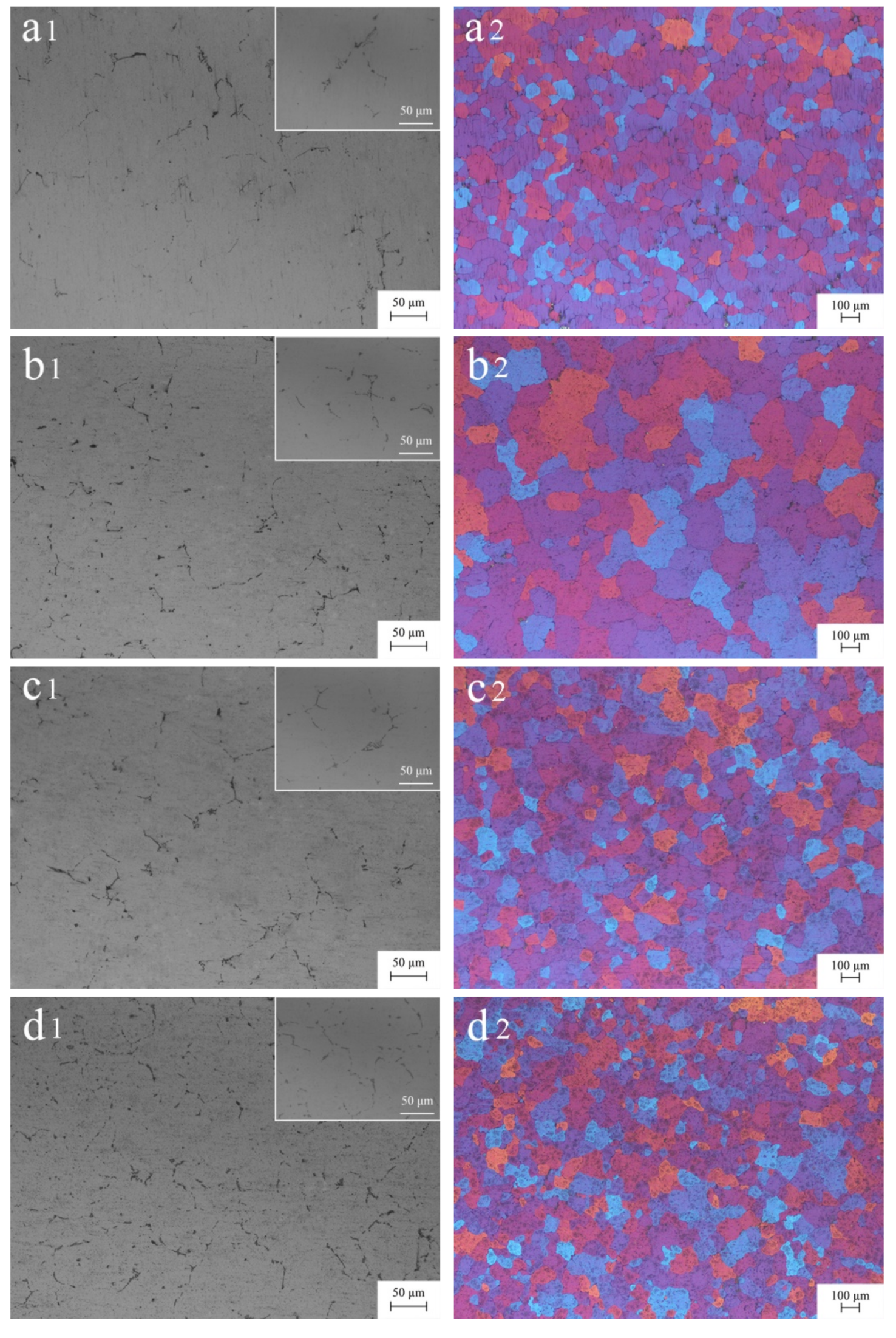


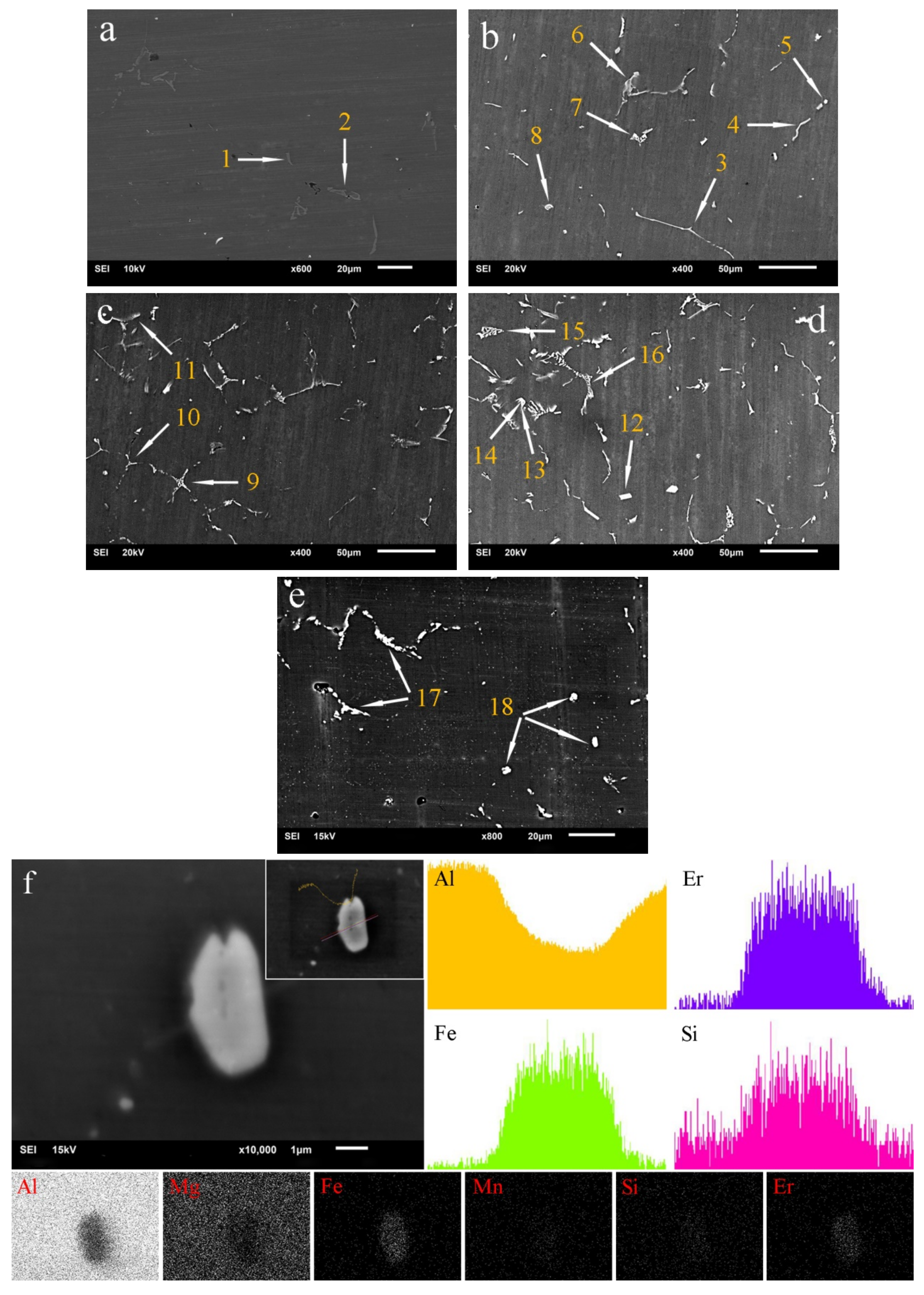
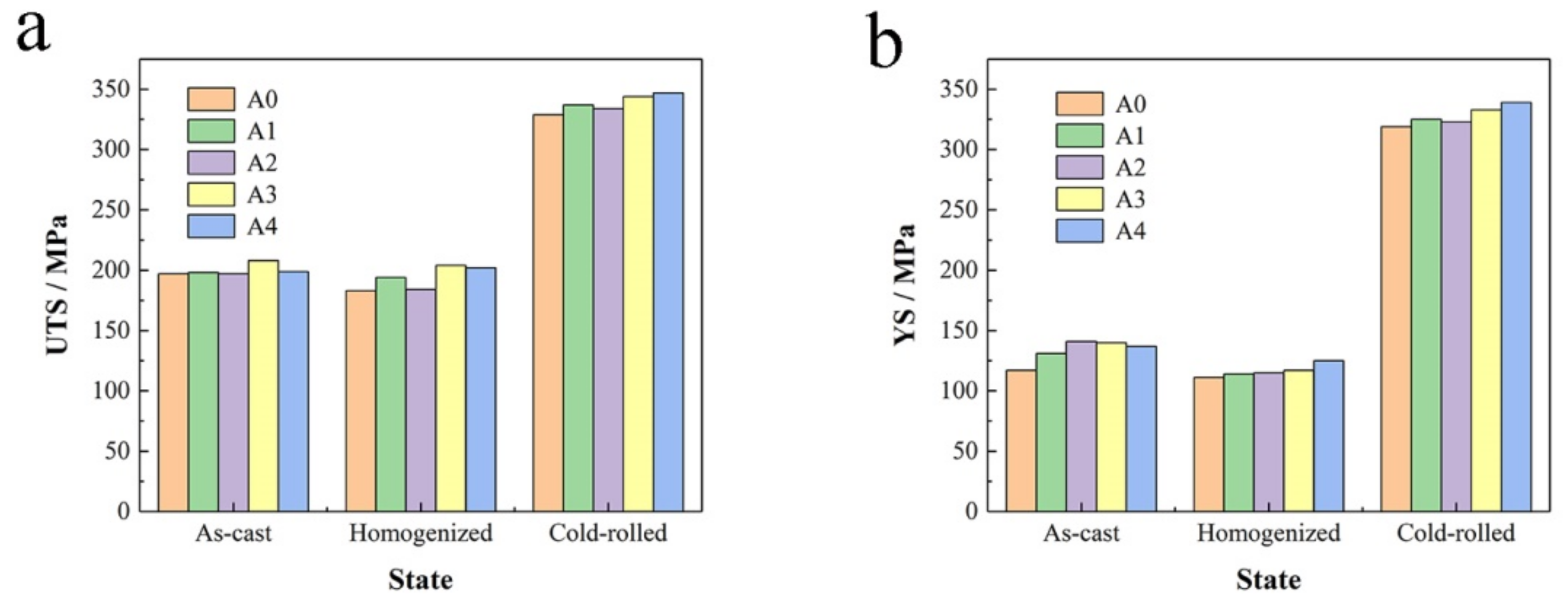

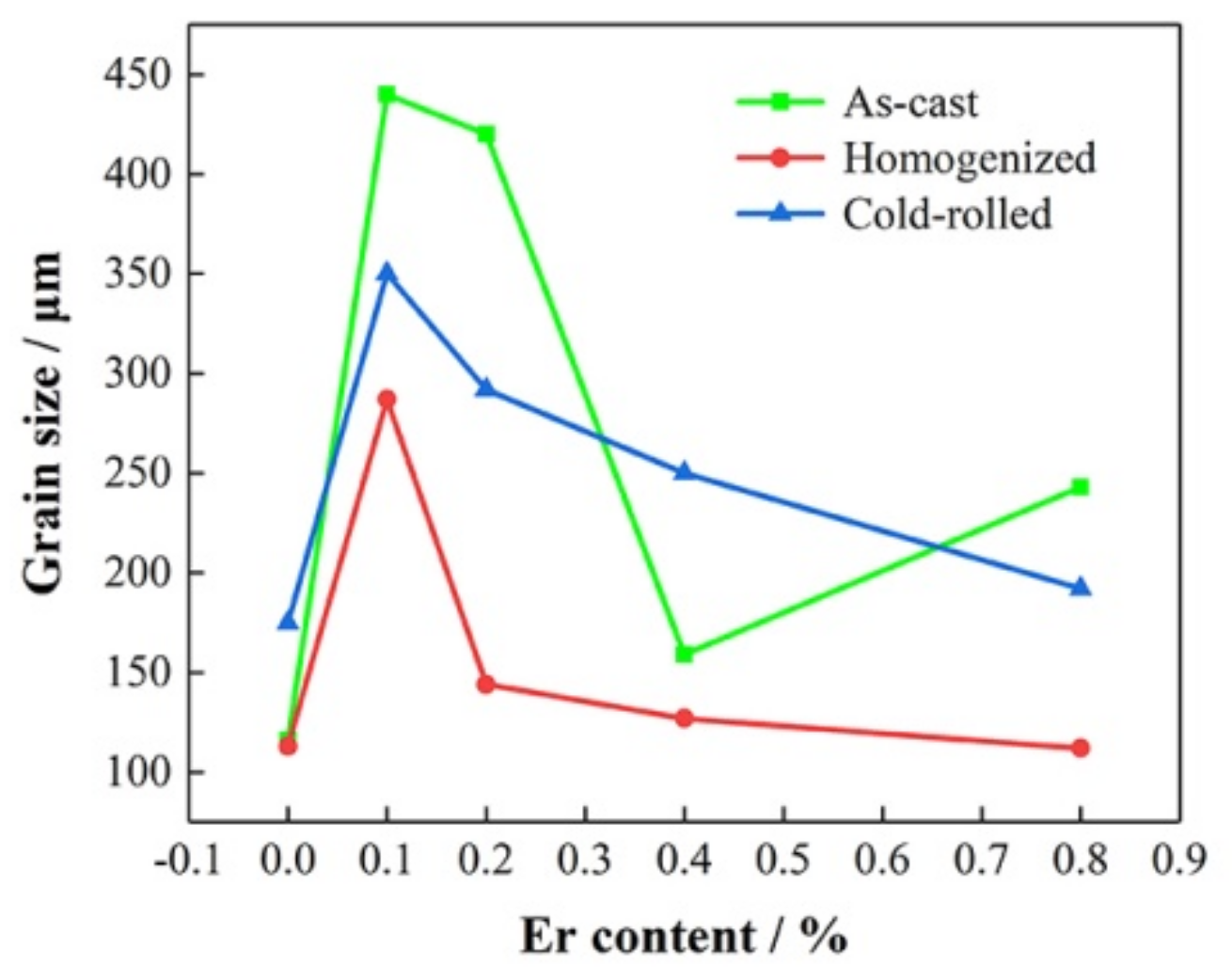
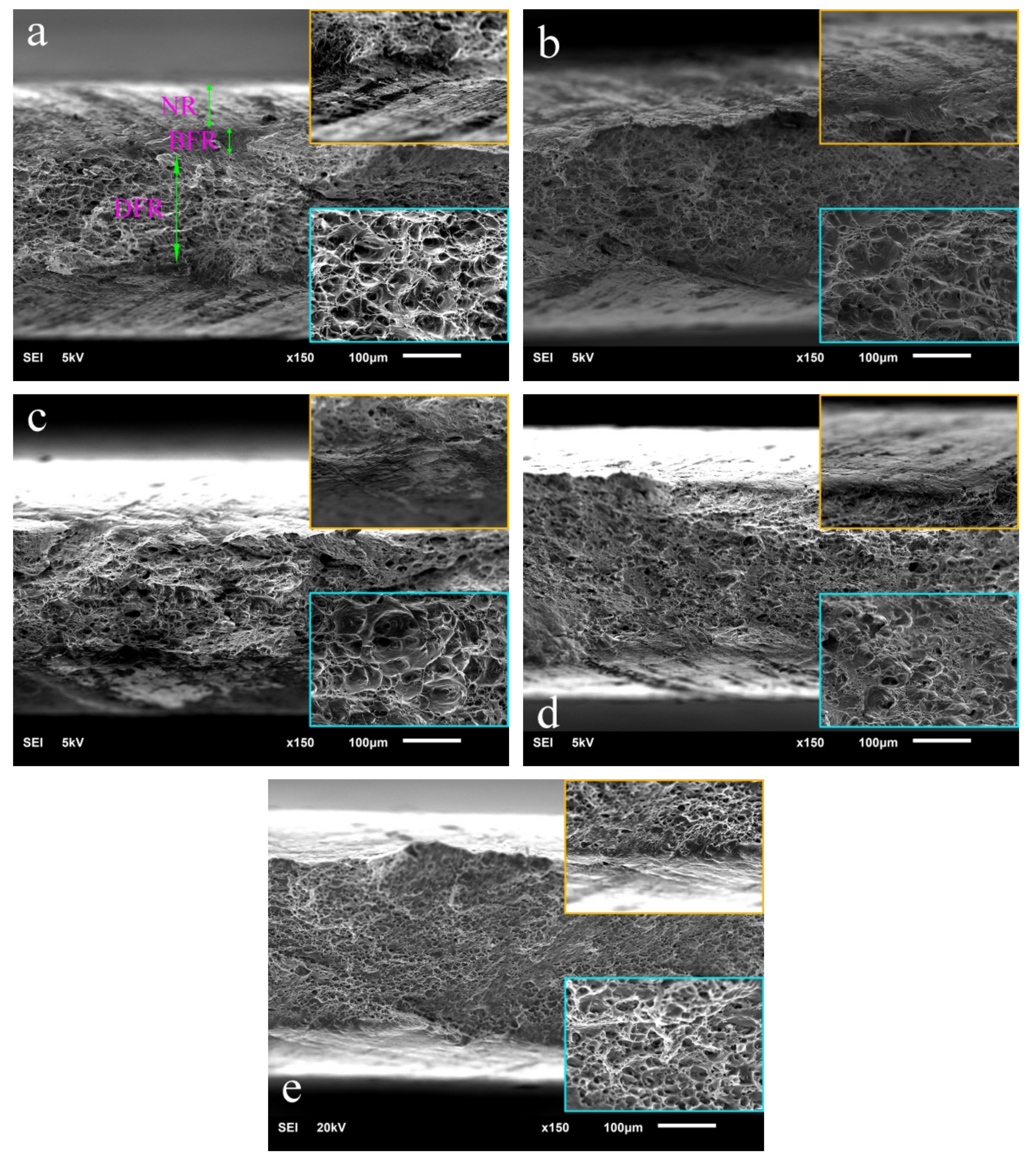
| Alloy | Elements | |||||||||
|---|---|---|---|---|---|---|---|---|---|---|
| Si | Fe | Cu | Mn | Mg | Cr | Zn | Ti | Er | Al | |
| A0 | 0.052 | 0.27 | 0.066 | 0.072 | 2.30 | 0.17 | 0.070 | 0.013 | 0 | Other |
| A1 | 0.042 | 0.26 | 0.070 | 0.071 | 2.37 | 0.16 | 0.065 | 0.010 | 0.1 | Other |
| A2 | 0.044 | 0.26 | 0.066 | 0.070 | 2.34 | 0.16 | 0.082 | 0.009 | 0.2 | Other |
| A3 | 0.053 | 0.26 | 0.064 | 0.068 | 2.42 | 0.18 | 0.085 | 0.010 | 0.4 | Other |
| A4 | 0.055 | 0.27 | 0.065 | 0.069 | 2.39 | 0.17 | 0.087 | 0.009 | 0.8 | Other |
| Arrow | Elements | |||||
|---|---|---|---|---|---|---|
| Al | Fe | Mg | Si | Er | Cr | |
| 1 | 70.86 | 29.14 | - | - | - | - |
| 2 | 71.24 | 27.82 | 0.94 | - | - | - |
| 3 | 86.68 | 11.85 | 1.26 | - | - | 0.21 |
| 4 | 89.00 | 8.70 | 1.88 | 0.42 | - | - |
| 5 | 85.65 | - | 2.37 | 1.13 | 10.85 | - |
| 6 | 90.28 | 7.99 | 1.73 | - | - | - |
| 7 | 91.33 | 0.29 | 1.56 | - | 6.82 | - |
| 8 | 91.28 | 0.41 | 2.01 | 0.73 | 5.57 | - |
| 9 | 92.90 | - | 2.95 | - | 4.15 | - |
| 10 | 93.33 | 0.80 | 2.82 | - | 3.05 | - |
| 11 | 91.82 | - | 3.08 | 0.85 | 4.25 | - |
| 12 | 85.38 | - | 7.25 | - | 1.92 | 5.45 |
| 13 | 93.58 | - | 3.57 | 2.85 | - | - |
| 14 | 90.88 | - | 2.29 | 0.96 | 5.87 | - |
| 15 | 93.57 | - | 2.82 | - | 3.61 | - |
| 16 | 87.51 | 0.90 | 1.49 | 0.88 | 9.22 | - |
| 17 | 79.27 | 12.89 | 0.30 | 0.81 | 6.73 | - |
| 18 | 80.21 | 11.27 | 1.38 | 0.82 | 6.32 | - |
| Alloy | As-Cast | Homogenized | Cold-Rolled | ||||||
|---|---|---|---|---|---|---|---|---|---|
| UTS | YS | EL | UTS | YS | EL | UTS | YS | EL | |
| A0 | 197 | 117 | 22.5 | 183 | 111 | 18.0 | 329 | 319 | 1.72 |
| A1 | 198 | 131 | 26.1 | 194 | 114 | 24.3 | 337 | 325 | 3.31 |
| A2 | 197 | 141 | 21.4 | 184 | 115 | 17.1 | 334 | 323 | 2.75 |
| A3 | 208 | 140 | 23.9 | 204 | 117 | 24.2 | 344 | 333 | 2.59 |
| A4 | 199 | 137 | 13.4 | 202 | 125 | 23.8 | 347 | 339 | 2.33 |
| Er Content | Grain Size | ||
|---|---|---|---|
| As-Cast | Homogenized | Cold-Rolled | |
| 0 | 116 | 113 | 175 |
| 0.1% | 440 | 287 | 350 |
| 0.2% | 420 | 144 | 292 |
| 0.4% | 159 | 127 | 250 |
| 0.8% | 243 | 112 | 192 |
© 2020 by the authors. Licensee MDPI, Basel, Switzerland. This article is an open access article distributed under the terms and conditions of the Creative Commons Attribution (CC BY) license (http://creativecommons.org/licenses/by/4.0/).
Share and Cite
She, X.; Jiang, X.; Qi, B.; Chen, K. Effect of Er on Microstructure and Mechanical Properties of 5052 Aluminum Alloy with Big Width-To-Thickness Ratio. Materials 2020, 13, 568. https://doi.org/10.3390/ma13030568
She X, Jiang X, Qi B, Chen K. Effect of Er on Microstructure and Mechanical Properties of 5052 Aluminum Alloy with Big Width-To-Thickness Ratio. Materials. 2020; 13(3):568. https://doi.org/10.3390/ma13030568
Chicago/Turabian StyleShe, Xinwei, Xianquan Jiang, Bao Qi, and Kang Chen. 2020. "Effect of Er on Microstructure and Mechanical Properties of 5052 Aluminum Alloy with Big Width-To-Thickness Ratio" Materials 13, no. 3: 568. https://doi.org/10.3390/ma13030568





